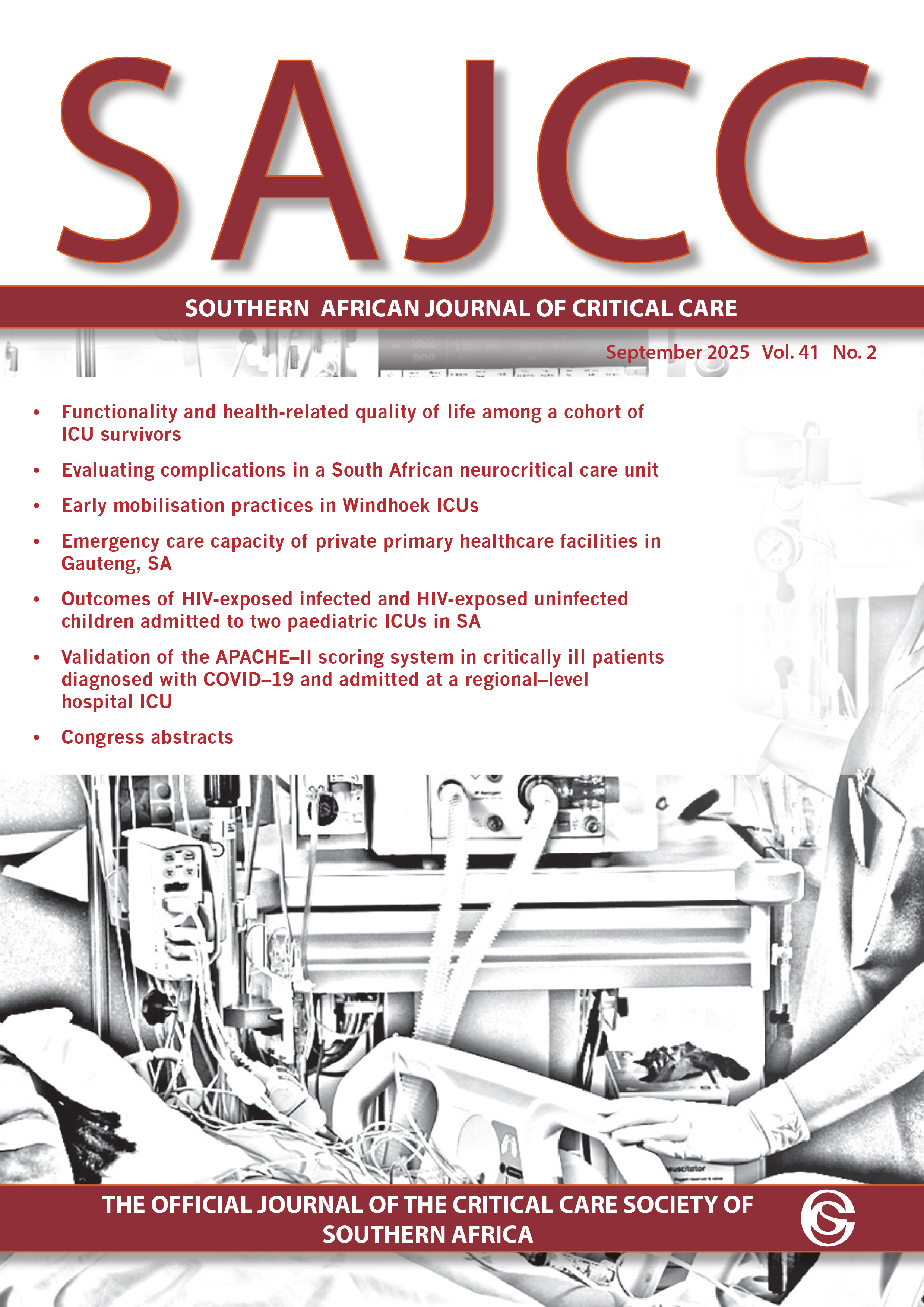Early mobilisation practices in Windhoek intensive care units: A retrospective review of patient profiles and physiotherapy practice
Main Article Content
Abstract
Background. Early mobilisation (EM) is safe and feasible with positive patient outcomes in various settings. However, data from Namibia in southern Africa are lacking, and the status of intensive care unit (ICU)-based mobilisation is unknown.
Objectives. To describe the mobility practices and profiles of critically ill patients in ICUs in Windhoek, Namibia.
Methods. A retrospective, descriptive record review was conducted in two private hospitals in Windhoek. Data were extracted using a self-designed electronic data abstraction form. The primary outcomes were the profile of ICU patients and documented mobility practices. Secondary outcomes included the timing and frequency of mobilisation, physiotherapy techniques used, and adverse events during physiotherapy. Patients with incomplete datasets or illegible records were excluded.
Results. The review included charts of 870 adult patients admitted to the participating ICUs between January and December 2016. Patients were predominantly male (61.8%; n=538), with a mean (standard deviation (SD)) age of 56 (14.9) years. Most admissions were planned (66.3%; n=577), mainly for coronary angiograms (20.6%; n=179), cardiac conditions (13.0%; n=113) and cardiac surgery (10.3%; n=90). The mean (SD) length of ICU stay was 3.41 (3.3) days, and the mean duration of mechanical ventilation was 0.7 (2.1) days. The overall ICU mortality rate was 5.2% (n=45). Of the 870 patients, 352 (40.5%) received physiotherapy, with 345 of these (98.0%) being mobilised. The median (interquartile range) length of ICU stay for mobilised patients was 3 (2 - 5) days, compared with 2 (2 - 3) days for non-mobilised patients (p<0.0001). Adverse events during physiotherapy were rare, occurring in only 5 patients (1.4%).
Conclusion. EM is often implemented as part of physiotherapy practice in Windhoek ICUs; however, fewer than half of the patients in this study received physiotherapy, highlighting the need for improved implementation of EM protocols and screening for readiness to mobilise.
Article Details
Issue
Section

This work is licensed under a Creative Commons Attribution-NonCommercial 4.0 International License.
The SAJCC is published under an Attribution-Non Commercial International Creative Commons Attribution (CC-BY-NC 4.0) License. Under this license, authors agree to make articles available to users, without permission or fees, for any lawful, non-commercial purpose. Users may read, copy, or re-use published content as long as the author and original place of publication are properly cited.
Exceptions to this license model is allowed for UKRI and research funded by organisations requiring that research be published open-access without embargo, under a CC-BY licence. As per the journals archiving policy, authors are permitted to self-archive the author-accepted manuscript (AAM) in a repository.
How to Cite
References
1. Harvey MA, Davidson JE. Postintensive care syndrome: Right care, right now and later. Crit Care Med 2016;44(2):381-385. https://doi.org/10.1097/CCM.0000000000001531
2. Appleton RTD, Kinsella J, Quasim T. The incidence of intensive care unit-acquired weakness syndromes: A systematic review. J Intensive Care Soc 2015;16(2):126-136. https://doi. org/10.1177/1751143714563016
3. Zhang L, Hu W, Cai Z, et al. Early mobilisation of critically ill patients in the intensive care unit: A systematic review and meta-analysis. PLoS ONE 2019;14(10):e0223185. https://doi. org/10.1371/journal.pone.0223185
4. Vanhorebeek I, Latronico N, van den Berghe G. ICU-acquired weakness. Intensive Care Med 2020;46(4):637-653. https://doi.org/10.1007/s00134-020-05944-4
5. Baby S, George C, Osahan NM. Intensive care unit-acquired neuromuscular weakness: A prospective study on incidences, clinical course, and outcomes. Indian J Crit Care Med 2021;25(9):1006-1012. https://doi.org/10.5005/jp-journals-10071-23975
6. Dinglas VD, Friedmann LA, Colantuoni E, et al. Muscle weakness and 5-year survival in acute respiratory distress syndrome survivors. Crit Care Med 2017;45(3):446-453. https://doi. org/10.1097/com.0000000000002208
7. Meyer-Frießem CH, Malewicz NM, Rath S, et al. Incidence, time course and influence on quality of life of intensive care unit-acquired weakness symptoms in long-term intensive care survivors. J Intensive Care Med 2021;36(11):1313-1322. http://doi.org/10.1177/0885066620949178
